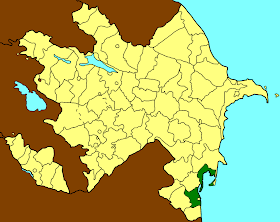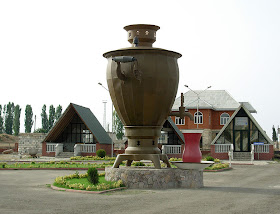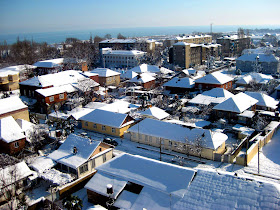Pages
▼
Thursday, May 24, 2012
Lankaran; a Famous City of Azerbaijan
 |
| Lankaran, Azerbaijan |
Lankaran (Azerbaijani: Lənkəran; also, Länkäran, Lencoran, and Lenkoran’,Talyshi:Lankon) (Arabic, Persian and Urdu: لنکران) is a city in Azerbaijan, on the coast of the Caspian Sea, near the southern border with Iran. It has a population of 83,300 (2010 census). It is next to, but independent of Lankaran rayon. The city forms a distinct first-order division of Azerbaijan.
Etymology:
The old form of the name was "Langarkanan" that in Persian means "the place of pulling up the anchor(s)" : "Langar" (Persian: لنگر, anchor) + "kan" (Persian: کن, to pull) + "an"(Persian: آن, suffix of places). However, some sources state that Lankaran is said to come from the Talish words for 'Cane house', which sounds as 'Lan Karan'. Alternatively, from Median *Lan(a)karan-, where *karan- means 'border, region, land' and Lan is probably a name of a Caspian tribe.
 |
| Lankaran's Location in Azerbaijan |
Geography:
There are sandy beaches near Lankaran. Thermal sulphide, chloride, sodium-calcium waters of Andjin (Upper and Lower) mineral springs are situated 12 km west of the town. Also to the west are the ruins of Ballabur castle, near the village with the same name.
The region has a vast area of national parks, where a variety of fauna and flora are preserved. Gizil-Agach State Reserve hosts over 250 kinds of plants, 30 species of fish and more than 220 kinds of birds. Lankaran is also known for Parrotia persica, or ironwood. It is naturally grown in the region and could be seen in Hirkan National Park. Local myth has it that it is the only wood that sinks in water, hence the name (ironwood). Historically it has been used for heating, since it burns for a long time and is not easily extinguished. The Persian leopard (Panthera pardus saxicolor) subspecies of the leopard, lives in the national park as well. In 1937, members of the Opilio lepidus species of harvestman were sited in the area.
Climate
Lankaran has a humid subtropical climate with a maximum annual precipitation of 1,600 to 1,800 mm, and is the highest precipitation in Azerbaijan.
History:
The city was built on a swamp along the northern bank of the river bearing the city's name. There are remains of human settlements in the area dating back to the Neolithic period as well as ruins of fortified villages from the Bronze and Iron Ages. Lankaran's history is rather recent, dating from the 16th century. Lankaran was for a long time the capital of the Talysh Khanate, which enjoyed variable degrees of independence throughout history. It was first a part of the Persian Empire. Later it was held by Russia from 1728 to 1735, but only fell definitively to Russia's General Kotlyarevsky in 1813, that status having been confirmed by the Treaty of Turkmenchay in 1828.
Once absorbed into the Russian empire, it became a part of the Azerbaijan Soviet Socialist Republic after the Russian revolution in 1917. In 1991, it became a part of independent Azerbaijan.
In 2011, Lankaran became a sister city to US California city of Monterey.
Economy:
Dominating spheres in Lankaran economy are vegetable-growing, tea-growing, paddy cultivating, cattle-breeding, citrus plants, beekeeping, fishing, and grain farming. Favourable humid subtropical climate, availability of good arable land, water and sufficient labour resources of city provides a good basis for agricultural activities as well as development of agro-processing enterprises. The city is also home of Azerbaijan's first tea plant, built in 1937
Demographics:
Lankaran is home to Azerbaijan's largest Talysh community.
Education:
The following universities are located in Lankaran:
Performing arts
Lankaran is home to several national folk performers, including the Bacılar (The Sisters) national Talysh folk and dance collective.
Cuisine:
Lankaran's cuisine has largely been affected by its multicultural history, hence the large variety of food originating during Talysh Khanate. Lankaran’s signature cuisine includes lavangi, Lankaran kulcha, marji plov, white plov, pumpkin plov and turshu kebab.
Main sights:
Sports:
The city has one professional football team competing in the top-flight of Azerbaijani football - Khazar Lankaran, currently playing in the Azerbaijan Premier League. 15,000 capacity Lankaran City Stadium regularly hosts, apart from Azerbaijan Premier League games, many other Lankaran-based teams and Azerbaijan national football team matches. In 2012, the city won to host European Masters Weightlifting Championship.
Transportation:
Lankaran is served by national and international flights through the Lankaran International Airport.
Connection with other cities and countries
There are sandy beaches near Lankaran. Thermal sulphide, chloride, sodium-calcium waters of Andjin (Upper and Lower) mineral springs are situated 12 km west of the town. Also to the west are the ruins of Ballabur castle, near the village with the same name.
The region has a vast area of national parks, where a variety of fauna and flora are preserved. Gizil-Agach State Reserve hosts over 250 kinds of plants, 30 species of fish and more than 220 kinds of birds. Lankaran is also known for Parrotia persica, or ironwood. It is naturally grown in the region and could be seen in Hirkan National Park. Local myth has it that it is the only wood that sinks in water, hence the name (ironwood). Historically it has been used for heating, since it burns for a long time and is not easily extinguished. The Persian leopard (Panthera pardus saxicolor) subspecies of the leopard, lives in the national park as well. In 1937, members of the Opilio lepidus species of harvestman were sited in the area.
 |
| A Street in Lankaran, Azerbaijan |
Lankaran has a humid subtropical climate with a maximum annual precipitation of 1,600 to 1,800 mm, and is the highest precipitation in Azerbaijan.
History:
The city was built on a swamp along the northern bank of the river bearing the city's name. There are remains of human settlements in the area dating back to the Neolithic period as well as ruins of fortified villages from the Bronze and Iron Ages. Lankaran's history is rather recent, dating from the 16th century. Lankaran was for a long time the capital of the Talysh Khanate, which enjoyed variable degrees of independence throughout history. It was first a part of the Persian Empire. Later it was held by Russia from 1728 to 1735, but only fell definitively to Russia's General Kotlyarevsky in 1813, that status having been confirmed by the Treaty of Turkmenchay in 1828.
Once absorbed into the Russian empire, it became a part of the Azerbaijan Soviet Socialist Republic after the Russian revolution in 1917. In 1991, it became a part of independent Azerbaijan.
In 2011, Lankaran became a sister city to US California city of Monterey.
 |
| A Central Street in Lankaran, Azerbaijan |
Dominating spheres in Lankaran economy are vegetable-growing, tea-growing, paddy cultivating, cattle-breeding, citrus plants, beekeeping, fishing, and grain farming. Favourable humid subtropical climate, availability of good arable land, water and sufficient labour resources of city provides a good basis for agricultural activities as well as development of agro-processing enterprises. The city is also home of Azerbaijan's first tea plant, built in 1937
Demographics:
Lankaran is home to Azerbaijan's largest Talysh community.
- Azerbaijanis 62.1% (31.151)
- Talysh 35.9% (17.935)
- Others 2% (1.024)
 |
| Lankaran State University |
The following universities are located in Lankaran:
- Lankaran State University - Founded in 1991, Lankaran State University is Lankaran's first university to start courses.
Performing arts
Lankaran is home to several national folk performers, including the Bacılar (The Sisters) national Talysh folk and dance collective.
 |
| Kichik Bazar Masjid, Lankaran |
Lankaran's cuisine has largely been affected by its multicultural history, hence the large variety of food originating during Talysh Khanate. Lankaran’s signature cuisine includes lavangi, Lankaran kulcha, marji plov, white plov, pumpkin plov and turshu kebab.
Main sights:
- Lankaran Fortress - built in 18th century.
- Boyuk Bazar Mosque
- Kichik Bazar Mosque
 |
| Lankaran City Stadium |
The city has one professional football team competing in the top-flight of Azerbaijani football - Khazar Lankaran, currently playing in the Azerbaijan Premier League. 15,000 capacity Lankaran City Stadium regularly hosts, apart from Azerbaijan Premier League games, many other Lankaran-based teams and Azerbaijan national football team matches. In 2012, the city won to host European Masters Weightlifting Championship.
Transportation:
Lankaran is served by national and international flights through the Lankaran International Airport.
 |
| Lankaran International Air Port |
- Air: The Lankaran International Airport is well served with connections to Turkish and international destinations. Its new international terminal was opened in September 2008 and the airport is set on its way for becoming one of the busiest hubs in Azerbaijan.
- Rail: The city has rail service from historic terminals in downtown to Baku in the east and Astara in the south.
- Jahan Talyshinskaya — folk singer and theatre actress.
- Hazi Aslanov — twice Hero of the Soviet Union.
- Mikhail Pavlov — Hero of Socialist Labor.
- Pasha Tahmazov — National Hero of Azerbaijan.
- Samedbey Mehmandarov — Russian army general, Minister of Defense of Azerbaijan Democratic Republic.



























































